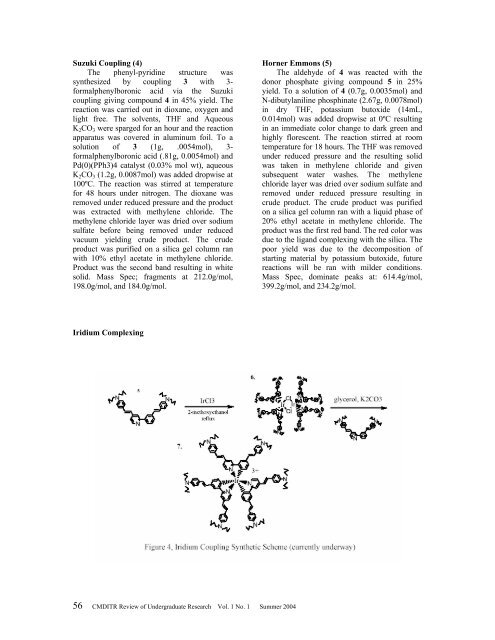CMDITR Review of Undergraduate Research - Pluto - University of ...
CMDITR Review of Undergraduate Research - Pluto - University of ...
CMDITR Review of Undergraduate Research - Pluto - University of ...
Create successful ePaper yourself
Turn your PDF publications into a flip-book with our unique Google optimized e-Paper software.
Suzuki Coupling (4)<br />
The phenyl-pyridine structure was<br />
synthesized by coupling 3 with 3-<br />
formalphenylboronic acid via the Suzuki<br />
coupling giving compound 4 in 45% yield. The<br />
reaction was carried out in dioxane, oxygen and<br />
light free. The solvents, THF and Aqueous<br />
K 2 CO 3 were sparged for an hour and the reaction<br />
apparatus was covered in aluminum foil. To a<br />
solution <strong>of</strong> 3 (1g, .0054mol), 3-<br />
formalphenylboronic acid (.81g, 0.0054mol) and<br />
Pd(0)(PPh3)4 catalyst (0.03% mol wt), aqueous<br />
K 2 CO 3 (1.2g, 0.0087mol) was added dropwise at<br />
100ºC. The reaction was stirred at temperature<br />
for 48 hours under nitrogen. The dioxane was<br />
removed under reduced pressure and the product<br />
was extracted with methylene chloride. The<br />
methylene chloride layer was dried over sodium<br />
sulfate before being removed under reduced<br />
vacuum yielding crude product. The crude<br />
product was purified on a silica gel column ran<br />
with 10% ethyl acetate in methylene chloride.<br />
Product was the second band resulting in white<br />
solid. Mass Spec; fragments at 212.0g/mol,<br />
198.0g/mol, and 184.0g/mol.<br />
Horner Emmons (5)<br />
The aldehyde <strong>of</strong> 4 was reacted with the<br />
donor phosphate giving compound 5 in 25%<br />
yield. To a solution <strong>of</strong> 4 (0.7g, 0.0035mol) and<br />
N-dibutylaniline phosphinate (2.67g, 0.0078mol)<br />
in dry THF, potassium butoxide (14mL,<br />
0.014mol) was added dropwise at 0ºC resulting<br />
in an immediate color change to dark green and<br />
highly florescent. The reaction stirred at room<br />
temperature for 18 hours. The THF was removed<br />
under reduced pressure and the resulting solid<br />
was taken in methylene chloride and given<br />
subsequent water washes. The methylene<br />
chloride layer was dried over sodium sulfate and<br />
removed under reduced pressure resulting in<br />
crude product. The crude product was purified<br />
on a silica gel column ran with a liquid phase <strong>of</strong><br />
20% ethyl acetate in methylene chloride. The<br />
product was the first red band. The red color was<br />
due to the ligand complexing with the silica. The<br />
poor yield was due to the decomposition <strong>of</strong><br />
starting material by potassium butoxide, future<br />
reactions will be ran with milder conditions.<br />
Mass Spec, dominate peaks at: 614.4g/mol,<br />
399.2g/mol, and 234.2g/mol.<br />
Iridium Complexing<br />
56 <strong>CMDITR</strong> <strong>Review</strong> <strong>of</strong> <strong>Undergraduate</strong> <strong>Research</strong> Vol. 1 No. 1 Summer 2004




